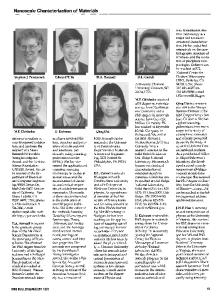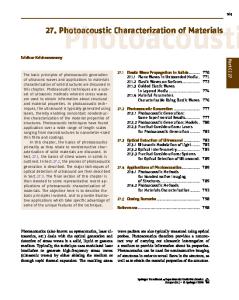Metallurgical Characterization of Joined Materials
This chapter describes the two typical examples of joining performance of structural and functional materials from the point of view of metallurgical characterization. At first, friction stir processing (FSP) is an effective grain refinement technique. FS
- PDF / 34,340,396 Bytes
- 601 Pages / 453.544 x 683.151 pts Page_size
- 89 Downloads / 376 Views
Structured Metallic and Inorganic Materials
Novel Structured Metallic and Inorganic Materials
Yuichi Setsuhara Toshio Kamiya Shin-ichi Yamaura •
•
Editors
Novel Structured Metallic and Inorganic Materials
123
Editors Yuichi Setsuhara Osaka University Osaka, Japan
Toshio Kamiya Tokyo Institute of Technology Yokohama, Japan
Shin-ichi Yamaura Tohoku University Sendai, Japan Present Address: The Polytechnic University of Japan Tokyo, Japan
ISBN 978-981-13-7610-8 ISBN 978-981-13-7611-5 https://doi.org/10.1007/978-981-13-7611-5
(eBook)
© Springer Nature Singapore Pte Ltd. 2019 This work is subject to copyright. All rights are reserved by the Publisher, whether the whole or part of the material is concerned, specifically the rights of translation, reprinting, reuse of illustrations, recitation, broadcasting, reproduction on microfilms or in any other physical way, and transmission or information storage and retrieval, electronic adaptation, computer software, or by similar or dissimilar methodology now known or hereafter developed. The use of general descriptive names, registered names, trademarks, service marks, etc. in this publication does not imply, even in the absence of a specific statement, that such names are exempt from the relevant protective laws and regulations and therefore free for general use. The publisher, the authors and the editors are safe to assume that the advice and information in this book are believed to be true and accurate at the date of publication. Neither the publisher nor the authors or the editors give a warranty, expressed or implied, with respect to the material contained herein or for any errors or omissions that may have been made. The publisher remains neutral with regard to jurisdictional claims in published maps and institutional affiliations. This Springer imprint is published by the registered company Springer Nature Singapore Pte Ltd. The registered company address is: 152 Beach Road, #21-01/04 Gateway East, Singapore 189721, Singapore
Preface
This book Novel Structured Metallic and Inorganic Materials is based on achievements in the joint research project “Advanced Materials Development and Integration of Novel Structured Metallic and Inorganic Materials”, which was carried out for 6 years (FY 2010–2015) through the cooperation of research groups in the following six institutes in Japan; the Institute for Materials Research, Tohoku University; the Materials and Structures Laboratory, Tokyo Institute of Technology; the Joining and Welding Research Institute, Osaka University; the EcoTopia Science Institute, Nagoya University; the Institute of Biomaterials and Bioengineering, Tokyo Medical and Dental University; and the Institute for Nanoscience and Nanotechnology, Waseda University. Major objectives of the six-institute joint research project included creation of advanced metallic and inorganic materials with the novel structure, as well as development of the materials-joining technologies for development of the cutting-edge applications as environmental and energy ma









